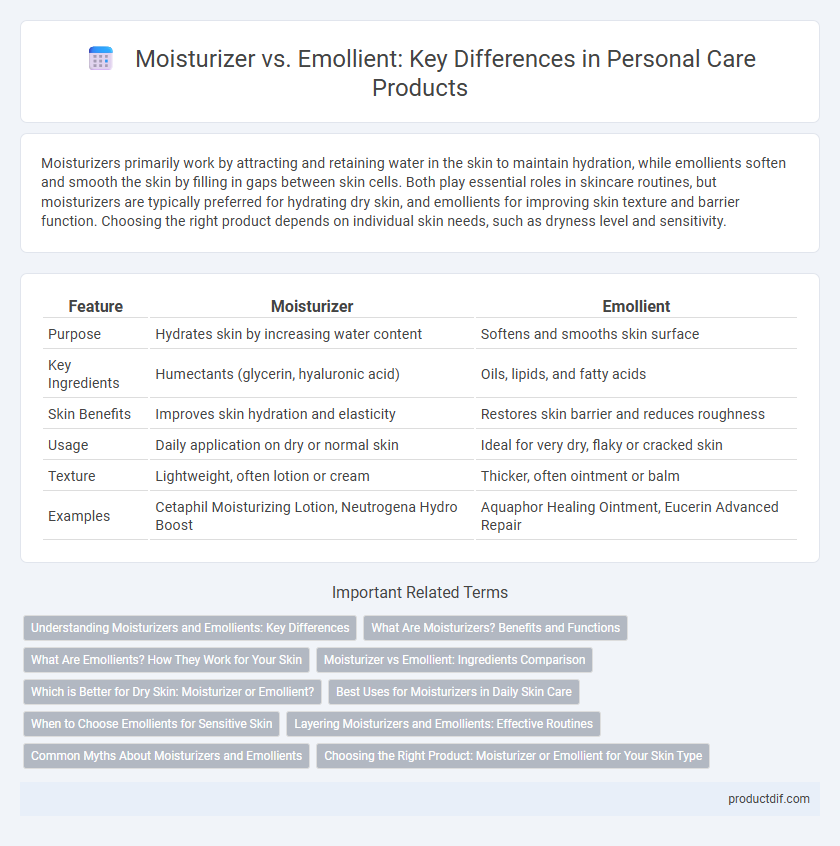Moisturizers primarily work by attracting and retaining water in the skin to maintain hydration, while emollients soften and smooth the skin by filling in gaps between skin cells. Both play essential roles in skincare routines, but moisturizers are typically preferred for hydrating dry skin, and emollients for improving skin texture and barrier function. Choosing the right product depends on individual skin needs, such as dryness level and sensitivity.
Table of Comparison
| Feature | Moisturizer | Emollient |
|---|---|---|
| Purpose | Hydrates skin by increasing water content | Softens and smooths skin surface |
| Key Ingredients | Humectants (glycerin, hyaluronic acid) | Oils, lipids, and fatty acids |
| Skin Benefits | Improves skin hydration and elasticity | Restores skin barrier and reduces roughness |
| Usage | Daily application on dry or normal skin | Ideal for very dry, flaky or cracked skin |
| Texture | Lightweight, often lotion or cream | Thicker, often ointment or balm |
| Examples | Cetaphil Moisturizing Lotion, Neutrogena Hydro Boost | Aquaphor Healing Ointment, Eucerin Advanced Repair |
Understanding Moisturizers and Emollients: Key Differences
Moisturizers primarily hydrate the skin by increasing its water content, while emollients work by softening and smoothing the skin surface to repair the lipid barrier. Moisturizers often contain humectants like glycerin or hyaluronic acid, which attract water, whereas emollients include oils and lipids such as petrolatum or shea butter that fill gaps between skin cells. Understanding these differences helps select the right product for dry, sensitive, or damaged skin conditions.
What Are Moisturizers? Benefits and Functions
Moisturizers are skincare products designed to hydrate the skin by increasing its water content, often containing humectants like glycerin and hyaluronic acid that attract moisture to the skin's surface. They provide benefits such as improving skin elasticity, reducing dryness, and creating a protective barrier to prevent water loss. Unlike emollients that primarily smooth and soften the skin by filling gaps between skin cells, moisturizers actively contribute to skin hydration and overall skin health.
What Are Emollients? How They Work for Your Skin
Emollients are lipid-based ingredients that fill the gaps between skin cells, creating a smooth and flexible surface by forming a protective barrier that locks in moisture. Unlike moisturizers, which primarily hydrate by attracting water to the skin, emollients soften and soothe dry or rough skin by replenishing lipids and restoring the skin's natural barrier function. Common emollients include shea butter, cetyl alcohol, and plant oils, making them essential for treating conditions like eczema and psoriasis by reducing irritation and improving skin texture.
Moisturizer vs Emollient: Ingredients Comparison
Moisturizers primarily contain humectants like glycerin and hyaluronic acid, which attract and retain water in the skin to enhance hydration. Emollients feature lipid-based ingredients such as shea butter, petrolatum, and fatty acids that fill gaps between skin cells, providing a smoothing and softening effect. Combining humectants in moisturizers with emollient oils optimizes skin barrier repair and moisture retention for comprehensive skin care.
Which is Better for Dry Skin: Moisturizer or Emollient?
Moisturizers contain humectants that attract water to the skin, providing immediate hydration, while emollients soften and smooth dry, flaky skin by filling gaps between skin cells with oils and lipids. For severe dry skin, emollients are often more effective due to their occlusive properties that lock in moisture and repair the skin barrier. Combining a moisturizer with emollient ingredients can offer the best results in maintaining hydration and improving skin texture for dry skin conditions.
Best Uses for Moisturizers in Daily Skin Care
Moisturizers are essential in daily skincare routines for hydrating and maintaining the skin's natural barrier by attracting and locking in moisture. They best suit all skin types, especially dry and sensitive skin, enhancing skin smoothness and preventing flakiness throughout the day. Unlike emollients that primarily soften and fill gaps between skin cells, moisturizers provide deeper hydration and long-lasting skin protection against environmental stressors.
When to Choose Emollients for Sensitive Skin
Emollients are ideal for sensitive skin due to their ability to create a protective barrier that locks in moisture and soothes irritation, unlike standard moisturizers which primarily add hydration. They contain ingredients like oils, lipids, and petrolatum that replenish the skin's natural lipids, reducing dryness and inflammation. Choosing emollients is essential for preventing flare-ups in conditions such as eczema and rosacea, where gentle, barrier-repairing care is critical.
Layering Moisturizers and Emollients: Effective Routines
Layering moisturizers and emollients enhances skin hydration by combining humectants that attract water with occlusive emollients that lock in moisture, creating a balanced skincare routine. Applying a lightweight moisturizer first allows for deeper hydration, while a thicker emollient sealant minimizes water loss and improves barrier function. This method maximizes hydration retention, reduces dryness, and supports overall skin health effectively.
Common Myths About Moisturizers and Emollients
Moisturizers and emollients are often confused, but they serve distinct functions in skin care; moisturizers primarily hydrate by attracting and retaining water, while emollients soften and smooth the skin's surface. A common myth is that emollients alone can hydrate the skin sufficiently, yet they mainly create a barrier to prevent moisture loss rather than add moisture. Understanding the difference helps choose the right product for conditions like dry or sensitive skin, optimizing skin health and comfort.
Choosing the Right Product: Moisturizer or Emollient for Your Skin Type
Selecting the right personal care product depends on your skin type and specific needs; moisturizers primarily hydrate by increasing water content in the skin, while emollients focus on softening and smoothing the skin's surface by filling in gaps between cells. For dry, flaky skin, emollients rich in oils and lipids offer effective barrier repair, whereas moisturizers containing humectants like hyaluronic acid attract and retain moisture for normal to combination skin. Understanding the distinct roles and ingredients of moisturizers versus emollients helps optimize skin health and maintain hydration balance.
moisturizer vs emollient Infographic

 productdif.com
productdif.com